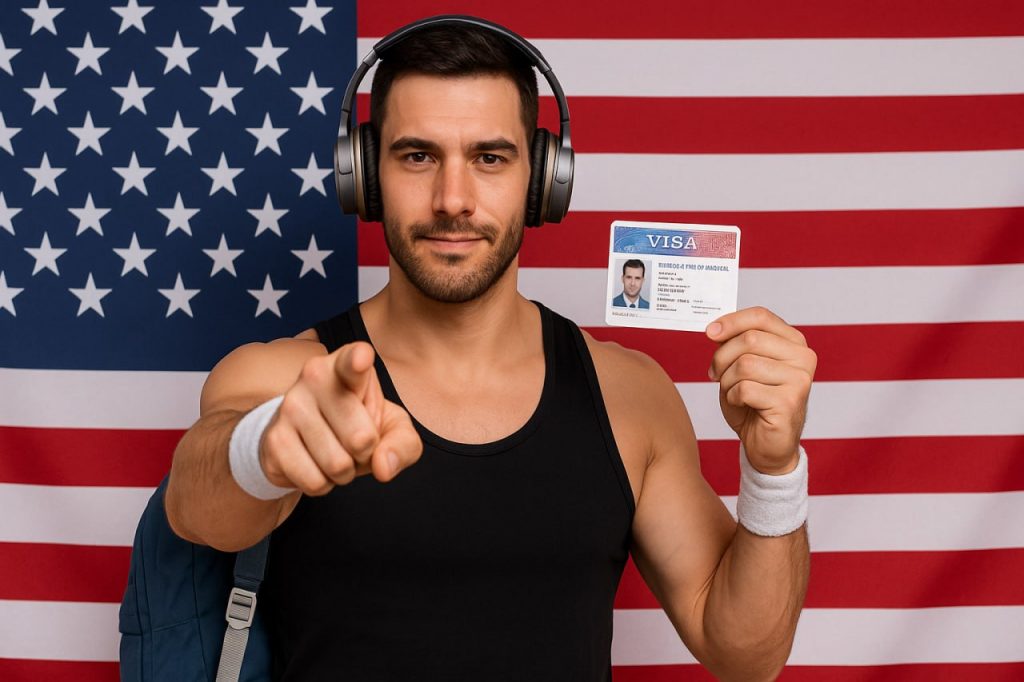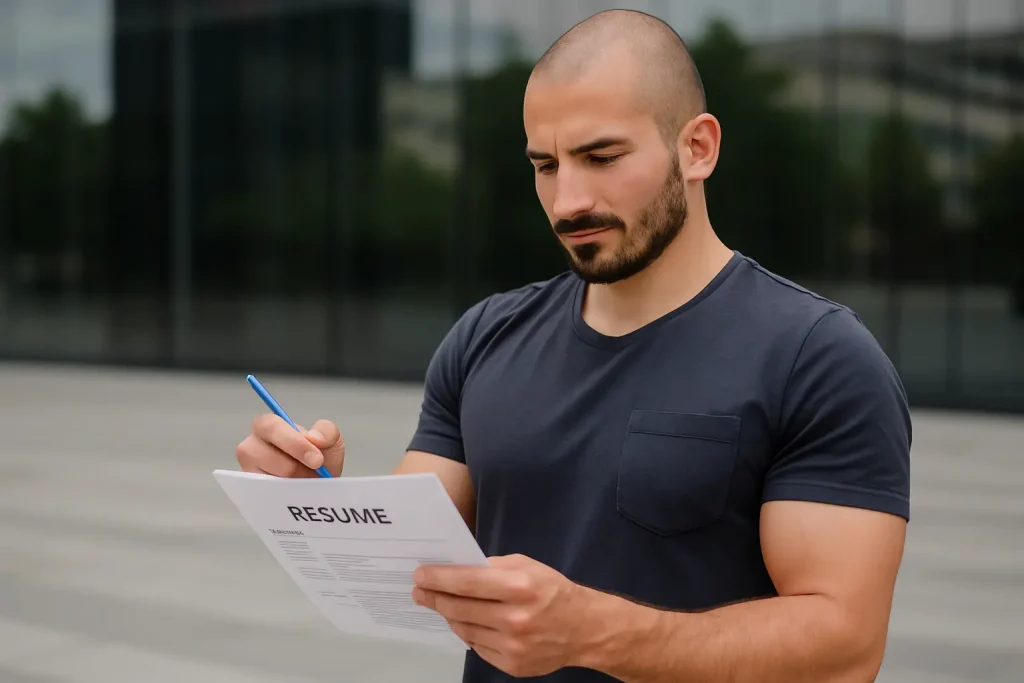EB-1 Visa for Fitness Trainers: A Successful Case and Immigration Strategy to the USA

A fitness trainer with outstanding achievements was able to obtain an EB-1 visa and a green card in the USA. The article analyzes the visa criteria, differences from the O-1 visa, stages of building the case, examples of publications, judging, international activities, and advice for professionals from any field.
Who Can Qualify for the EB-1 Visa

EB-1 Visa is one of the most prestigious categories of immigration visas to the United States, specially designed to attract individuals who demonstrate exceptional, outstanding achievements in their professional field. This visa does more than just open doors to the U.S.; it offers a direct path to permanent residency (green card), recognizing and valuing the applicant’s global contribution.
It’s important to understand that the term “extraordinary achievements” in the context of the EB-1 visa is interpreted much more broadly than one might initially assume. It goes beyond traditional academic or artistic fields and includes areas such as:
- Science: Revolutionary research, discoveries, significant publications in peer-reviewed journals, patents.
- Business: Founding successful companies, innovative business models, major contributions to the economy, market leadership.
- Arts: Outstanding performance or creative works, critical acclaim, awards, major exhibitions.
- Education: Teaching at a high level, developing unique educational programs, publications.
- Sports: Achievements at the national or international level, records, awards.
However, the scope of the EB-1 visa extends beyond these traditional areas. It also includes applied professions, where innovation and mastery can be equally significant.
A great example is the fitness industry, where fitness trainers, dietitians, rehabilitation specialists, and other professionals can demonstrate extraordinary abilities through:
- International Recognition: Participation in international championships, awards from prestigious sports or fitness organizations, publications of original methods in leading professional journals.
- Innovation: Development of new training methods, nutrition programs, fitness applications, or standards that transform the industry.
- Impact: Significant influence on fitness industry trends, training other professionals, judging at prestigious competitions or conferences.
A key point is that these achievements must place the applicant at the top or among the few best in their field, recognized at a national or international level.
Differences Between the EB-1 Visa and the O-1 and Other Immigration Categories
Understanding the distinctions between the EB-1 visa and other categories, such as the O-1 visa (for individuals with extraordinary ability), is crucial for choosing the right immigration path.
Status and Purpose:
- EB-1 Visa: This is an immigrant visa, the ultimate goal of which is obtaining a green card and, consequently, permanent residency in the United States. It is intended for individuals who aim to make the U.S. their long-term home.
- O-1 Visa: This is a non-immigrant visa (temporary) that grants the right to stay in the U.S. temporarily for work or performances in a specific field. It is usually issued for up to three years with the possibility of extension but does not lead directly to a green card.
Employer/Sponsor Requirement:
- EB-1 Visa (in most subcategories, especially EB-1A “Extraordinary Ability”): Does not require a prior job offer and, accordingly, does not require a U.S. employer. The applicant can self-petition, which makes it especially attractive for highly qualified professionals. The exception is the EB-1B subcategory “Outstanding Professors and Researchers,” which does require employer sponsorship.
- O-1 Visa: Requires a U.S. employer or agent who will act as the petitioner and prove the necessity of the applicant’s presence for a specific job or project.
Focus of Evidence:
- EB-1 Visa: The main focus is on documented evidence of the applicant’s exceptional and unique achievements. The case is built on an extensive portfolio of evidence that demonstrates national or international recognition.
- O-1 Visa: Also requires proof of extraordinary ability, but the emphasis is on a current or future contract/invitation for work in the U.S., which explains why this specific professional is needed.
Thus, if your goal is permanent residence in the U.S. and you have outstanding achievements, the EB-1 visa offers a more direct and independent path.
Why Education Is Not Critical for the EB-1 Visa
One of the most progressive and distinctive aspects of the EB-1 visa is its focus on real professional accomplishments and impact, rather than formal academic qualifications. This means:
- A diploma is not a mandatory requirement: Unlike many other immigration categories where higher education is often a cornerstone, for the EB-1 visa a candidate may qualify without a university degree or even a formal academic credential.
- Recognition by the professional community matters more than diplomas: What truly counts are actual achievements acknowledged by the professional community at the national or international level. This can be proven in various ways:
- Participation in significant competitions: Wins or prize places in prestigious national or international professional competitions or physical training contests.
- Judging: Invitations to serve as a judge or jury member at professional fitness competitions, indicating authority and expertise.
- Publications: Authorship of articles, books, or other materials in leading professional or industry publications (e.g., fitness journals, sports medicine), demonstrating contribution to the body of knowledge.
- Membership in exclusive associations: Belonging to professional organizations in fitness and health that require outstanding achievements for membership.
- International activities: Invitations to speak, consult, or work internationally (e.g., conducting training seminars abroad).
- High salary: Evidence of significantly higher earnings compared to other specialists in your field.
- Commercial success: Significant commercial success, for example, from selling proprietary training programs or health products.
This approach makes the EB-1 visa accessible to self-taught individuals, innovators, and practitioners whose talents and contributions have been recognized beyond academic walls. The key is a documented track record of exceptional achievements demonstrating that the applicant is among the elite in their profession.
Hard to figure it out?
Write to us – we will help!
How a Fitness Trainer Successfully Prepared a Resume for the EB-1 Visa: A Real Case Study

This example demonstrates how a fitness trainer with outstanding achievements successfully built their EB-1 visa case, emphasizing that extraordinary abilities are not limited to traditional academic or scientific fields. The key was systematically accumulating evidence across multiple criteria required for this visa category.
Early Start and Establishment in Ukraine
The professional development of the fitness trainer began with creating their own online project in Ukraine focused on personalized training and nutrition programs.
This project was not only a commercial initiative but also a foundation for forming an expert identity, encouraging active participation in educational and practical activities.
This step demonstrated initiative, leadership, and a deep understanding of the industry.
Alongside business growth, they actively engaged in educational activities.
Initially, this involved organizing and conducting training events with the involvement of recognized trainers or dietitians. This showed their organizational skills and commitment to raising industry standards.
Having developed their own professional methodology (an author’s system of functional training or a unique approach to working with specific muscle groups), the applicant transitioned from organizer to mentor, initiating a series of author-led workshops focused on spreading new standards in fitness and healthy lifestyle.
International Development and Global Influence
The next logical step was expanding activities to the international level.
The candidate did not just passively attend events but actively participated in them, which is important for EB-1.
Their trips abroad included:
- Participation in international seminars and conventions: This demonstrated his commitment to continuous learning and improvement.
- Organization of own courses and seminars: Particularly important was that he began organizing training programs on the international stage. In each new country – be it Sweden, England, or Germany – he not only deepened his knowledge but also shared his unique experience and techniques with local specialists. This emphasized his international influence and recognition as a teacher and expert.
Publications, Author Courses, and Monographs: Proof of Expert Status
At a certain stage of his professional path, the candidate began engaging in publishing activities, which became critically important for EB-1.
- Publications in professional journals: Regular articles in leading industry journals on fitness, healthy lifestyle, or sports medicine and online platforms confirmed his expertise and contribution to the development of fitness theory and practice. This showed that his knowledge and experience are recognized and disseminated within the professional community.
- Creation of author courses: Development of proprietary, unique training programs (for example, for trainers or a broad audience) that go beyond standard methods, indicating his innovative approach and leadership in education.
- Writing an author book on training methods or healthy nutrition: This arguably became one of the most substantial proofs of his expert status and pioneer role in his niche. Publishing a book is a significant achievement, demonstrating deep knowledge, the ability to systematize information, and making a meaningful contribution to the field.
Judging, Competitions, and Own Championships: Authority and Influence in the Industry
The culmination of his professional development was active judging and event organization:
- Judging at international fitness contests or competitions: Serving as a judge at contests in various countries, including European Union nations, was a strong point in his resume. It confirmed his authority, impartiality, and ability to assess the skills of others, which is a direct indicator of recognition at his own outstanding level.
- Organization of own events and championships: The clearest evidence of his authority and influence in the industry was creating and hosting his own professional fitness events and training camps. This not only demonstrated his leadership and organizational skills but also confirmed his role as a key figure shaping the industry, setting standards, and discovering new talents.
Thus, the fitness trainer’s resume for the EB-1 visa was successfully built on the basis of many years of diverse and well-documented achievements covering criteria of extraordinary ability: from entrepreneurial activity and international teaching to publications, judging, and organizing large-scale projects.
Why This Resume Works: Analysis of Strengths for the EB-1 Visa
The success of the fitness trainer’s resume for the EB-1 visa lies in its ability to convincingly demonstrate extraordinary abilities across several key criteria required by the U.S. immigration service. Let’s analyze the strengths of this case.
Chronological Structure: From Local Initiative to Global Expertise
One of the most convincing aspects of this resume is its chronological structure.
It does not just list achievements but builds a sequential story of professional growth and gradual expansion of competencies. The resume clearly shows how the applicant developed:
- From a local initiative (opening a studio or online project in Ukraine) – demonstrating entrepreneurial spirit and the first steps in the industry.
- To national recognition (organizing trainings in Ukraine).
- And then to international expertise (traveling, teaching, and judging abroad).
This approach allows the visa officer to see not random successes but a planned ascent to the top of the profession, which is compelling evidence of exceptional ability.
Geography and Participation in Judging: Recognition Beyond the Country
The geographic scope of the candidate’s activities is an extremely important criterion for the EB-1 visa, especially for specialists in applied fields such as fitness trainers.
When a trainer acts as a judge at competitions in other countries, it unequivocally indicates recognition of their qualifications and authority beyond their home country.
This is not just a personal achievement; it is evidence that their expertise is valued and in demand internationally.
For the EB-1 visa, it is crucial to prove that the applicant is “one of the few best” in their field nationally or internationally, and judging in various countries is a vivid confirmation of this.
Author Courses and Educational Activities: Impact on Industry Development
Creating proprietary training programs and implementing unique methodologies are powerful proofs of innovation and leadership. These elements shape the image of a professional who not only follows trends but actively influences the development of the entire industry.
Conducting masterclasses, seminars, and training sessions, especially at the international level, demonstrates that the applicant shares knowledge and experience, raising the overall professionalism in the industry. This indicates that their work significantly impacts other specialists and industry standards.
Creating Own Products and Platforms: Contribution to the Industry
Finally, creating own products and platforms, whether commercial or educational content, is another convincing proof of extraordinary ability. This includes:
- Author Books: Such as a book on training methods or healthy nutrition, demonstrating deep knowledge, the ability to systematize information, and contributing to the theoretical base of the industry.
- Online Courses and Educational Applications: This shows adaptation to modern technologies and the ability to scale influence, making knowledge accessible to a wide audience.
- Own Brands of Sports Nutrition or Equipment: If the development and promotion of own products have achieved significant commercial success or recognition.
Such contribution to the industry not only demonstrates expertise but also confirms that the applicant is an innovator and a shaping figure, creating value and resources for the entire professional sphere.
What Other Professionals Should Consider: Lessons from a Successful EB-1 Case

This case of a fitness trainer is an inspiring example for any professional aiming for immigration through the EB-1 visa. It demonstrates that extraordinary abilities can be found and proven in a variety of fields. Here are the key takeaways:
Don’t be afraid to include “small” facts: Every contribution matters
One of the main misconceptions when preparing a resume for EB-1 is the belief that only “big” and obvious achievements, such as international awards or patents, matter. However, this case shows that this is not true. You should not hesitate to include in your resume even those facts that may seem small or insignificant at first glance.
- Teaching others: If you have trained colleagues, interns, conducted internal seminars, or shared knowledge in your field, this confirms your expert status and influence on others. For a fitness trainer, this could even be small masterclasses for colleagues or individual consultations with high results.
- Participation in events: Active involvement in professional conferences, exhibitions, forums, even as an attendee or panel discussion participant, demonstrates your engagement in the industry and drive for growth.
- Organizing local events: Even if you organized small fitness marathons, professional meetups, or other local events, this shows your leadership qualities, organizational skills, and ability to impact the community.
All these elements combined form a picture of continuous professional growth, initiative, and contribution to the community, which is the foundation for proving extraordinary ability.
Why Even “Simple” Professions Can Lead to a Green Card
The fitness trainer case clearly breaks stereotypes about who can qualify for the EB-1 visa.
A fitness trainer is not the “traditional” path to the U.S. from the perspective of academic elite or big business. However, this profession in this case showed how attention to detail, continuous growth, and deep involvement in the international professional community can become a solid foundation for obtaining the EB-1 visa.
The essence is that the immigration service evaluates not the prestige of the profession’s title but the level of your achievements within that profession. If you are at the top of your field, regardless of how “simple” it may seem from the outside, you have a chance.
This example proves that innovation, influence, and recognition exist in all fields of activity, and it is important only to present them correctly.
What to Take from This Case in Any Field of Activity
The main conclusion that can be drawn from this successful case applies to any professional, regardless of the field:
The key to success is not the position or industry, but the path.
- Compelling growth story: Show how you developed from the starting point to your current level, overcoming challenges and acquiring new skills.
- Achievements: Clearly and documentarily confirm your most significant successes. These may include publications, awards, patents, commercial success, creation of unique methods (for example, author’s training or nutrition programs).
- Recognition: Prove that your achievements are recognized by other experts in your field. This can include participation as a judge, invitations to speak, citations of your work, membership in exclusive associations (e.g., international fitness federations).
- Impact: Demonstrate how your work has influenced other people, your industry, or society as a whole. This may include teaching others, creating products that change the market (e.g., popular fitness apps), or developing standards.
These elements – a compelling growth story, achievements, recognition, and impact – form a strong resume for immigration through the EB-1 visa.
How to Start the Path to EB-1 Visa: First Steps

If you are considering obtaining an EB-1 visa but don’t know where to start, don’t worry. The most important thing is to begin collecting and organizing information about your professional activities. Here are the key first steps:
Start Simple: Create a Detailed List of Your Achievements
The first and most important step is to compile an exhaustive list of all your professional activities and achievements over recent years. This is your personal “inventory” of your career. Don’t leave out anything that you think might be related to your professional activity, even if it seems insignificant at first glance.
Include in this list:
- Participation: Attendance at conferences, seminars, webinars, exhibitions (both as a listener and a participant) in the fields of fitness, healthy lifestyle, sports medicine.
- Training: Any courses, trainings, masterclasses you attended or, even more importantly, conducted for others (e.g., courses for beginner trainers, seminars on specialized methodologies). Specify topics, dates, duration, and number of participants.
- Publications: Your articles in professional fitness publications, blogs, books, manuals, online materials you authored.
- Projects: Description of key projects you worked on (e.g., development of fitness programs for corporations, creation of online platforms), your role, achieved results, and their impact.
- Awards and Recognition: Any prizes, diplomas, letters of appreciation, certificates in the fitness field.
- Membership in Organizations: Professional associations or communities (e.g., international fitness associations) you belong to.
- Media: Mentions of you or your work in press, TV, radio, or popular online editions (e.g., interviews about your methodologies).
- Judging/Evaluation: If you served as a judge, expert, reviewer, or mentor at fitness competitions or in professional journals.
- Event Organization: Your experience organizing any professional fitness events, even local ones.
- Financial Indicators: If you demonstrate a significantly higher salary compared to other trainers in your field or notable commercial success of your fitness products/services.
Don’t Be Afraid to Describe Everything You’ve Done: Details Matter
People often underestimate their achievements, considering them “insignificant.” This is a big mistake when preparing for EB-1. Even if it seems that some event was “insignificant” or “obvious,” be sure to include it in your list and describe it in detail.
For example, if you regularly conducted internal trainings for colleague trainers, this shows your leadership and expertise. If you were invited to speak at a local professional fitness community meeting, it indicates your recognition within the community. Such details, collected together, demonstrate the evolution of your professional path and continuous development. They help form a complete picture of your contribution to the industry, showing that you did not just perform your job but actively grew and influenced your field.
Don’t Compare Your Path to Others – Build Your Unique Case
One of the most important lessons from the fitness trainer case is this: the EB-1 visa is not a template route, and your path to it should not be a copy of someone else’s. The success story of the fitness trainer clearly shows that there is no universal “template” for EB-1. It doesn’t matter if you work as a programmer, artist, athlete, or, as in this example, a fitness trainer.
Everyone has a unique path, and the important thing is to present it correctly and convincingly. Instead of comparing yourself to others and thinking you have “insufficient” achievements compared to someone else, focus on proving your value and uniqueness of your professional contribution. Your task is to collect all evidence that you are among the “few best” in your specific field, whatever its name.
The key is your compelling growth story, supported by documentary evidence of recognition and impact.
Still have questions?
Write to us, and our lawyer will help you understand your situation.
